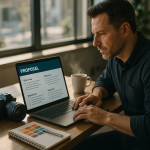Use event press coverage to amplify your online presence and search ranking
You just appeared in the press after covering an event—great! Now learn how to transform that fleeting spotlight into sustainable online visibility, stronger authority signals and, ultimately, higher search rankings that convert readers into new clients.
Why event press coverage is an SEO goldmine

When a respected media outlet mentions your brand, it creates three immediate advantages: beyond the obvious prestige, press citations act as shortcuts in the complex trust-building process that algorithms perform. Google treats editorial references almost like votes from a verified authority, so a single feature can deliver more ranking power than dozens of self-published blog posts created over months. The resulting authority signals cascade through every linked page, amplifying topical relevance and accelerating indexation speed in ways that organic content efforts alone rarely match.
- High-authority backlinks from the publication's website to yours.
- Brand mentions that feed Google's entity recognition and E-E-A-T signals.
- Referral traffic spikes that tell search engines your content deserves a boost.
Combine the three and you obtain a compounding effect that pushes you closer to page-one results, much faster than relying on organic blogging alone.
Step-by-step: turn media mentions into lasting ranking signals
1. Secure a live backlink—don't settle for plain text
Journalists often credit you with a name only. Write a friendly follow-up email within 24 hours asking for a clickable link to your preferred landing page. Provide anchor text such as “portfolio of event stories” to help the editor and boost relevance.
2. Optimise the linked page for fresh intent
Traffic from press articles is curious and time-poor. Refresh the landing page with:
- A concise event highlight reel above the fold.
- Schema markup (Article or VideoObject) for rich snippets.
- Internal CTAs that guide visitors toward your booking form or smart outreach tips.
3. Leverage the press logo across owned channels
Add an “As seen in …” bar on your homepage, newsletter header and social banners. The visual cue heightens trust and click-through rates—two behavioural metrics Google watches closely.
4. Repurpose the story into multiple assets
- Turn statistics or quotes into shareable infographics.
- Create a behind-the-scenes blog post linking back to the original article.
- Record a short video commentary for LinkedIn and embed it on your page.
5. Strengthen topical authority with related content
Write at least two supporting articles that explore angles the press piece could not cover in depth. For example, complement a feature on your event photography with guidance on standing out in creative directories or local SEO tactics for visual professionals. Interlink them to form a subject cluster.
Distribution channels that multiply reach
| Channel | Why it matters | Action Item |
|---|---|---|
| Newsletter | Warms existing leads | Embed pull-quotes & add “book now” button |
| Professional validation | Post an article with canonical tag to your blog | |
| Instagram Stories | Real-time proof | Swipe-up link to press page |
| Event photographers directory | Long-tail discovery | Update your event photographers directory listing with the press badge |
Measure success and iterate

Track the following KPIs four weeks after publication: treat the numbers like a feedback loop, not a verdict set in stone. Patterns in ranking volatility, user engagement and conversion funnels will show you whether your optimisation steps work or need refinement, long before revenue reports arrive. By reviewing granular data early, you preserve momentum while the press echo is still audible, allowing you to double down on distribution tactics that move the needle and abandon those that waste effort.
- Organic keyword positions for “event + your niche”.
- Referral traffic volume and dwell time from the media site.
- Conversion rate of visitors who land on the optimised page.
- Backlink growth using tools like Google Search Console.
Adjust your internal link structure if certain pages underperform. Our guide on quick SEO wins walks you through rapid fixes.
Interactive quiz: are you maximising your press coverage?
FAQ
- Do no-follow links from press still help SEO?
- Yes. Even without direct PageRank transfer, they provide brand signals and can drive engaged traffic, which indirectly supports ranking.
- Should I pay for a press feature?
- Google discourages sponsored links that aren't labelled. Focus on earning organic coverage through compelling stories and expert commentary.
- How many internal links should my press landing page include?
- Two to four highly relevant links keep users exploring without overwhelming them. Each should deepen the topic and guide toward conversion.
- What if the publication refuses to add a backlink?
- Politely accept the mention and double down on distributing the feature across your channels. The brand citation alone still strengthens authority.
Key takeaways
- Act fast: secure the backlink and update your page within 24 hours.
- Repurpose relentlessly: video, blog, newsletter and social proof.
- Track and iterate: measure rankings, traffic and conversions monthly.
Ready to harness your next media spotlight? Put these steps into action and watch your search visibility climb—then explore advanced influence metrics to quantify the impact.











